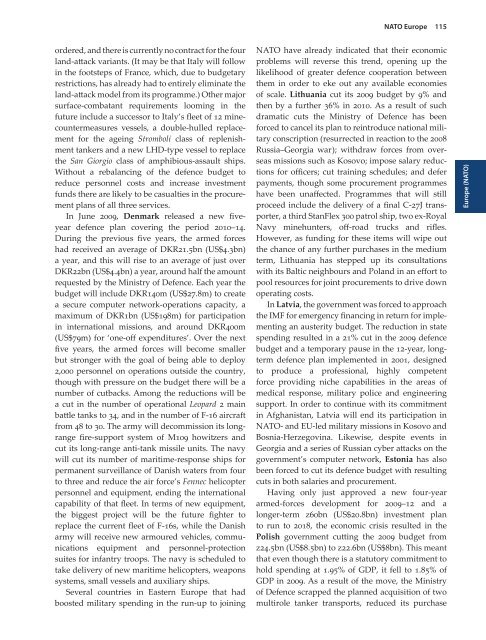Create successful ePaper yourself
Turn your PDF publications into a flip-book with our unique Google optimized e-Paper software.
ordered, and there is currently no contract for the four<br />
land-attack variants. (It may be that Italy will follow<br />
in the footsteps of France, which, due to budgetary<br />
restrictions, has already had to entirely eliminate the<br />
land-attack model from its programme.) Other major<br />
surface-combatant requirements looming in the<br />
future include a successor to Italy’s fleet of 12 mine-<br />
countermeasures vessels, a double-hulled replacement<br />
for the ageing Stromboli class of replenishment<br />
tankers and a new LHD-type vessel to replace<br />
the San Giorgio class of amphibious-assault ships.<br />
Without a rebalancing of the defence budget to<br />
reduce personnel costs and increase investment<br />
funds there are likely to be casualties in the procurement<br />
plans of all three services.<br />
In June 2009, Denmark released a new fiveyear<br />
defence plan covering the period 2010–14.<br />
During the previous five years, the armed forces<br />
had received an average of DKR21.5bn (US$4.3bn)<br />
a year, and this will rise to an average of just over<br />
DKR22bn (US$4.4bn) a year, around half the amount<br />
requested by the Ministry of Defence. Each year the<br />
budget will include DKR140m (US$27.8m) to create<br />
a secure computer network-operations capacity, a<br />
maximum of DKR1bn (US$198m) for participation<br />
in international missions, and around DKR400m<br />
(US$79m) for ‘one-off expenditures’. Over the next<br />
five years, the armed forces will become smaller<br />
but stronger with the goal of being able to deploy<br />
2,000 personnel on operations outside the country,<br />
though with pressure on the budget there will be a<br />
number of cutbacks. Among the reductions will be<br />
a cut in the number of operational Leopard 2 main<br />
battle tanks to 34, and in the number of F-16 aircraft<br />
from 48 to 30. The army will decommission its longrange<br />
fire-support system of M109 howitzers and<br />
cut its long-range anti-tank missile units. The navy<br />
will cut its number of maritime-response ships for<br />
permanent surveillance of Danish waters from four<br />
to three and reduce the air force’s Fennec helicopter<br />
personnel and equipment, ending the international<br />
capability of that fleet. In terms of new equipment,<br />
the biggest project will be the future fighter to<br />
replace the current fleet of F-16s, while the Danish<br />
army will receive new armoured vehicles, communications<br />
equipment and personnel-protection<br />
suites for infantry troops. The navy is scheduled to<br />
take delivery of new maritime helicopters, weapons<br />
systems, small vessels and auxiliary ships.<br />
Several countries in Eastern Europe that had<br />
boosted military spending in the run-up to joining<br />
naTO Europe<br />
115<br />
NATO have already indicated that their economic<br />
problems will reverse this trend, opening up the<br />
likelihood of greater defence cooperation between<br />
them in order to eke out any available economies<br />
of scale. Lithuania cut its 2009 budget by 9% and<br />
then by a further 36% in 2010. As a result of such<br />
dramatic cuts the Ministry of Defence has been<br />
forced to cancel its plan to reintroduce national military<br />
conscription (resurrected in reaction to the 2008<br />
Russia–Georgia war); withdraw forces from overseas<br />
missions such as Kosovo; impose salary reductions<br />
for officers; cut training schedules; and defer<br />
payments, though some procurement programmes<br />
have been unaffected. Programmes that will still<br />
proceed include the delivery of a final C-27J transporter,<br />
a third StanFlex 300 patrol ship, two ex-Royal<br />
Navy minehunters, off-road trucks and rifles.<br />
However, as funding for these items will wipe out<br />
the chance of any further purchases in the medium<br />
term, Lithuania has stepped up its consultations<br />
with its Baltic neighbours and Poland in an effort to<br />
pool resources for joint procurements to drive down<br />
operating costs.<br />
In Latvia, the government was forced to approach<br />
the IMF for emergency financing in return for implementing<br />
an austerity budget. The reduction in state<br />
spending resulted in a 21% cut in the 2009 defence<br />
budget and a temporary pause in the 12-year, longterm<br />
defence plan implemented in 2001, designed<br />
to produce a professional, highly competent<br />
force providing niche capabilities in the areas of<br />
medical response, military police and engineering<br />
support. In order to continue with its commitment<br />
in Afghanistan, Latvia will end its participation in<br />
NATO- and EU-led military missions in Kosovo and<br />
Bosnia-Herzegovina. Likewise, despite events in<br />
Georgia and a series of Russian cyber attacks on the<br />
government’s computer network, Estonia has also<br />
been forced to cut its defence budget with resulting<br />
cuts in both salaries and procurement.<br />
Having only just approved a new four-year<br />
armed-forces development for 2009–12 and a<br />
longer-term z60bn (US$20.8bn) investment plan<br />
to run to 2018, the economic crisis resulted in the<br />
Polish government cutting the 2009 budget from<br />
z24.5bn (US$8.5bn) to z22.6bn (US$8bn). This meant<br />
that even though there is a statutory commitment to<br />
hold spending at 1.95% of GDP, it fell to 1.85% of<br />
GDP in 2009. As a result of the move, the Ministry<br />
of Defence scrapped the planned acquisition of two<br />
multirole tanker transports, reduced its purchase<br />
Europe (naTO)


